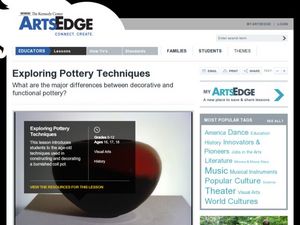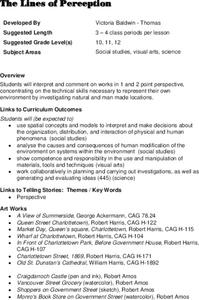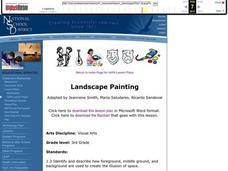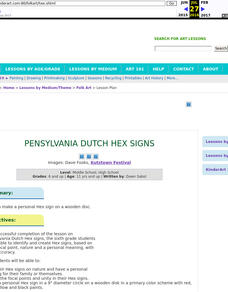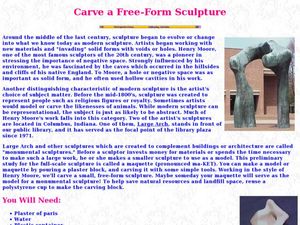Curated OER
Repeat After Me: Repetition in the Visual Arts
Students explore one of the techniques artists often use to highlight important elements within a painting's composition and to move a viewer's eye around the canvass from highpoint to highpoint.
Curated OER
Repeat After Me: Repetition in the Visual Arts
Students identify repetition in the composition of a variety of art works, and how it is used to create a unified composition. They discuss compositional structure of a painting.
Curated OER
Our Client Is The Cincinnat Art Museum
Students design various commercial products for the Cincinnati Art Museum using on-line sources, past designs, and creative educational software. This lesson has excellent project ideas for various student levels including: K-2, 3-5,...
Sargent Art
Destination Art: Paper Mola Collage
The Kuna Indians hail from the San Blas Island near Panama. Learners will investigate their culture by creating paper mola collages, just like the ones created by the indigenous Panamanians. They'll focus on understanding the symbolism...
Curated OER
Natural Beauty: Looking Sharp
Students create covers for their "nature journals" using watercolor techniques and the artistic ideas of color, depth, and focal point. This lesson can be used in the Science or Art classroom and meets national standards for both.
Curated OER
Principles of Design
How to use the many design elements such as color harmony, percentage of size combinations, and lines of design are described. Composition of an attractive arrangement with a focal point is addressed. Also included, many...
Curated OER
A River Ran Wild: An Environmental History
The Nashua River serves as the focal point of an investigation of the treatment of and care for natural resources. A reading of A River Rand Wild: An Environmental History by Lynne Cherry, launches the study and class members consider...
Curated OER
Exploring Pottery Techniques
Students examine Native American pottery. In this visual arts activity, students analyze burnished and glazed clay pots. Students study how to create pots from online sources and respond to questions about the process. Extension...
Curated OER
The Lines of Perception
Here are four engaging lessons that focus on visual art, but also bring in elements of science and social studies. Learners view artwork, locate focal points, and visit and research community sites. They conduct internet research, and...
Curated OER
Shaping the View: Composition Basics
Students are introduced to the concept of composition in visual art. They examine various compositional structures and practice identifying the focus of various pieces of art.
Curated OER
Movie Books- Children's Stories
Students use iMovie to write, illustrate, and narrate a movie book to bring their story alive visually and capture the interest of and inspire nonreaders at their school.
Curated OER
Self Biography
Get to know your learners with this project. Each individual writes an autobiography that is at least seven pages long with major facts, visual facts, focal stories, and chronology. The activity includes a point breakdown for the...
Curated OER
Self Portrait using watch parts and tin - Mixed media
Young scholars create whimsical self portraits using watch parts and tin - recycling. They demonstrate safety in using tools. They use a variety of materials to create a work of art , and demonstrate understanding of the elements and...
Curated OER
The Lines of Perception
Students interpret and comment on works in 1 and 2 point perspective. They locate the focal point of works done in 1 point perspective and create a drawing of a street or landscape in their local area using 1 point perspective.
Curated OER
Landscape Painting
Third graders paint a landscape that demonstrates the illusion of space. For this visual arts lesson, 3rd graders paint a creek with reflections as the focus and include images showing foreground, middle ground, and background...
Curated OER
Shaping the View: Composition Basics
Students examine the elements of composition in various artworks. They analyze and discuss paintings, explore "The National Gallery of Art" website, identify the shape of compositions in paintings, and draw a diagram.
National Endowment for the Humanities
Lesson 1: In Depth with the Full Spectrum
High schoolers study the ways in which an artist can use color. They view various images of artwork and discuss the effect of color on spacial dimensions, focal points, tone, and mood.
Curated OER
Shaping the View: Symmetry and Balance
Students view an image from the Metropolitan Museum of Art and identify the focal point of the painting. They discuss symmetry and balance as it pertains to the images. Students use the Student LaunchPad (linked to this lesson) to help...
Curated OER
Living on the Edge - "Illegal Art"
Students explore how copyright and trademark laws impact art. After researching cases on the topic, students use and existing postcard as the basis for a new piece of art.
Curated OER
Pennsylvania Dutch Hex Signs
Sixth graders identify and create Hex signs, based on unity, focal point, nature and a personal meaning,
Curated OER
Adventures of Huckleberry Finn
Twelfth graders read The Adventures of Huckleberry Finn and choose the ten most important adventures of the novel for a timeline activity. For this Huckleberry Finn lesson, 12th graders read the novel and list the adventures....
Curated OER
Composition With Red Hat
Students create a work of art that includes a red hat, either as a focal point or as an accent in the picture. The picture could be in color or black and white with the hat in red and they choose the medium that they want to use.
Curated OER
Carve a Free-Form Sculpture
Students construct a free-from sculpture. In this sculpting lesson, students use plaster of paris, a malt cup, and finishing tools to create a sculpture. Students share their finished art pieces.
Curated OER
Shaping the View: Composition Basics
High schoolers view images from the Metropolitan Museum of Art web site, and list the objects and figures in the image. They discuss the way their eyes move around the canvas and take note of where their eyes fall, follow and finish....









